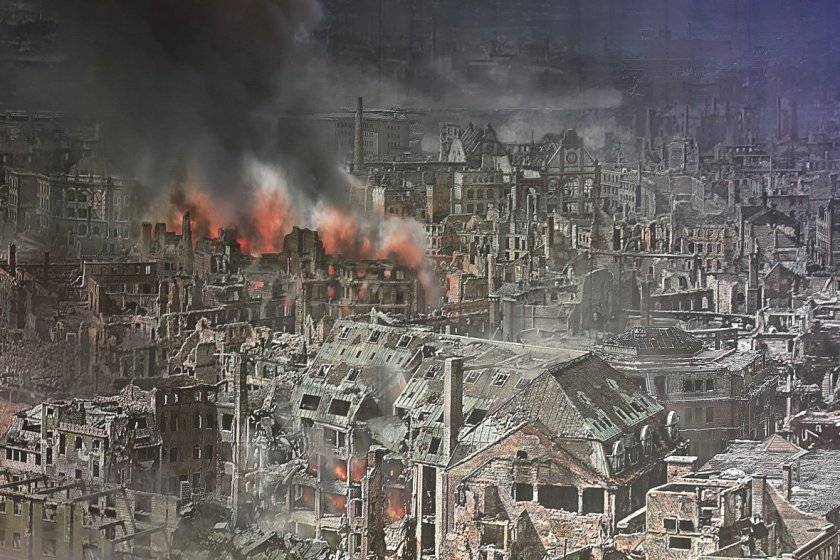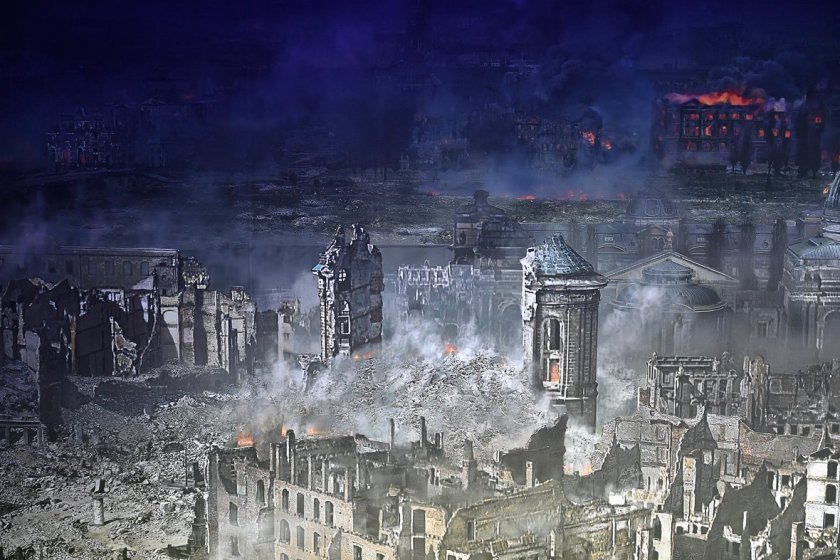The most destructive war in history entered its final, apocalyptic phase in January 1945, with another four months of hard fighting yet remaining before Allied forces could declare victory in Europe. In the west, the “Battle of the Bulge” was ended, the last great effort of German arms spent and driven back beyond original lines. In the east, the once mighty German military contracted in on itself, in the face of a massive Soviet advance.
Dozens of German divisions hurried east to meet the threat. Allied intelligence believed the war could be over in April if the major cities to the east, were destroyed. Dresden. Leipzig. Chemnitz. Letting these places stand to serve as bases for retreating German forces, could drag the war out until November.

Sir Charles Portal, British Chief of the Air Staff, put the problem succinctly: “We should use available effort in one big attack on Berlin and attacks on Dresden, Leipzig, and Chemnitz, or any other cities where a severe blitz will not only cause confusion in the evacuation from the East, but will also hamper the movement of troops from the West.”
With its baroque and rococo city center, the capital city of Dresden was long described as the “Jewel Box” of the Free State of Saxony, family seat to the Polish monarchs and royal residence to the Electors and Kings of Saxony. Dresden was the seventh-largest city in Germany in 1945, home to 127 medium-to-large sized factories supplying the German war machine, and the largest built-up area in the “thousand-year Reich”, yet to be bombed.

For Victor Klemperer, the 13th of February, 1945, was the most terrifying and depressing experience of a lifetime. Once home to well over 6,000 Jews, Dresden now contained a mere forty-one. Klemperer’s marriage to an “Aryan” wife had thus far protected him from the “final solution”, despite the yellow Juden star he was forced to wear on his coat.
Now, the man witnessed notices for final “deportation” being delivered even to those last few. There wasn’t one who received such a notice who didn’t understand what it meant. Terrified that he might be next the process was interrupted by the coming firestorm. Three nights later Klemperer removed the yellow star, an act punishable by death at the time.
Three hundred miles away, bad weather hampered operations for the United States Army Air Force (USAAF). The first wave in the fire bombing of Dresden would be a Royal Air Force (RAF) operation.

The first group of Lancaster bombers arrived in the skies over Dresden two hours before midnight, February 13. These were the pathfinders, their job to find the place and drop magnesium parachute flares, to light up the target. Then came the marker planes, Mosquito bombers whose job it was to drop 1,000-pound target indicators whose red glare provided something to aim at. Then came the first wave, 254 Lancaster bombers dropping 500 tons of high explosives ranging from 500-pounders to massive, 4,000-pound “blockbusters”. Next came the incendiaries. The “fire bombs”. 200,000 of them.
For those caught on the ground like scared rabbits in oncoming headlights, the horrors had only begun.

The second wave came in the small hours of February 14, just as rescue operations were getting underway. By now thousands of fires were burning, with smoke rising 15,000 feet into the air. You could see it from the air, from five hundred miles.
Then came another 529 Lancasters, dropping another 1,800 tons of bombs.

The USAAF arrived over the target on the afternoon of February 14, the 317 B-17 “Flying Fortresses” of the “Mighty 8th” delivering another 771 tons of bombs.
Fires enveloped the city by the tens of thousands growing into a great, howling firestorm. A shrieking, seemingly living demon beast from the blackest pits of hell, devouring all in its path.
A firestorm of this size develops its own weather, fire tornadoes reaching into the sky as pyrocumulonimbus clouds hurl lightning bolts back to earth, starting new fires. Gale force winds scream into the vortex from all points of the compass, powerful enough to hurl grown adults opening doors in an effort to flee, off their feet and into the flames.
Lothar Metzger brings us one of the few eyewitness accounts of the fire bombing of Dresden, as seen from the ground:
“It is not possible to describe! Explosion after explosion. It was beyond belief, worse than the blackest nightmare. So many people were horribly burnt and injured. It became more and more difficult to breathe. It was dark and all of us tried to leave this cellar with inconceivable panic. Dead and dying people were trampled upon, luggage was left or snatched up out of our hands by rescuers. The basket with our twins covered with wet cloths was snatched up out of my mother’s hands and we were pushed upstairs by the people behind us. We saw the burning street, the falling ruins and the terrible firestorm. My mother covered us with wet blankets and coats she found in a water tub.
We saw terrible things: cremated adults shrunk to the size of small children, pieces of arms and legs, dead people, whole families burnt to death, burning people ran to and fro, burnt coaches filled with civilian refugees, dead rescuers and soldiers, many were calling and looking for their children and families, and fire everywhere, everywhere fire, and all the time the hot wind of the firestorm threw people back into the burning houses they were trying to escape from.
I cannot forget these terrible details. I can never forget them”.
He was ten years old at the time.

For Victor Klemperer, the fire bombing of Dresden was a last minute reprieve. On the 19th he joined a refugee column fleeing the inferno, for American held territory. He would survive the attack, and live to see the end of the war.
Official death tolls from the burned out city are estimated at 18,500 to 25,000. The real number will never be known. At this point in the war refugees and military forces were streaming through the area by the tens of thousands. Estimates run as high as 200,000. That number if accurate, is more than death tolls resulting from the atomic bombings of Hiroshima and Nagasaki, combined.


